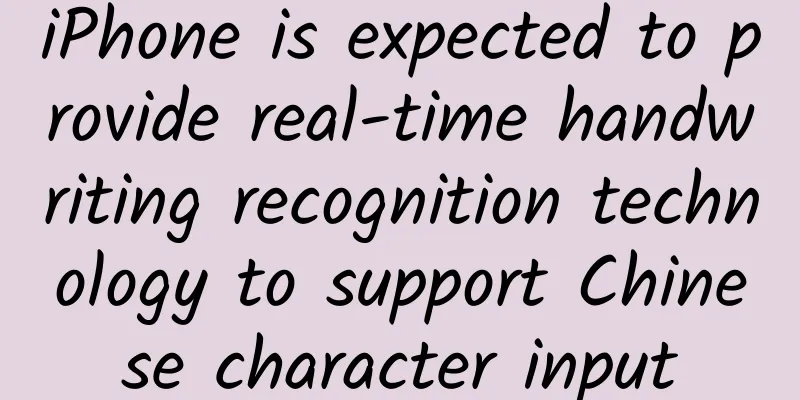iPhone is expected to provide real-time handwriting recognition technology to support Chinese character input

|
Apple seems to be actively developing a handwriting recognition system, which means that once this system is completed, users will be able to input text directly on the iPhone or iPad screen by handwriting in the future, instead of relying on the use of a virtual keyboard, and it may also natively support the input of Chinese characters. Speaking of handwriting recognition, many people may know that Apple has tried similar products before, but the progress was not smooth. As early as the 1990s, Apple had launched a powerful handheld computer: Newton. One of the key highlights of the device was the handwriting recognition function, but this function was not ideal, which was one of the reasons why Newton performed poorly in the PDA market. Although some issues with Newton's handwriting recognition were resolved in subsequent system software versions, Jobs still decided to kill the Newton device. In fact, Newton is already a very old device. Nowadays, technology has made great progress. A large number of devices support text input through handwriting touch screens, including Windows and Android devices. Apple seems to have come out of the failure of Newton and recently applied for a patent for managing "real-time handwriting recognition technology." This patent was applied for on February 15 this year and was recently published by the US Patent and Trademark Office. Since there is a patent, it shows that Apple has done some research on the technology involved in the patent. According to the patent description, this is very much like "a technology that provides handwriting input function on a user device", and it also mentions that users "can use fingers, or a stylus like Apple Pencil" to input handwriting, supporting real-time conversion. At present, most users input text on mobile devices through the virtual keyboard on the screen, which is basically the habit of everyone, especially smartphone users. But it is not ideal in some cases, such as when using a smartphone or tablet with a large screen. Many users said that it is awkward to input text with a 12.9-inch iPad Pro, and the efficiency of typing with both hands is extremely low without laying it flat on the table. Therefore, in this case, it is obviously more convenient to write text or sentences directly on the large screen with your fingers, without having to adjust the angle and posture of the device. Therefore, if real-time handwriting recognition technology can appear on iOS devices, it will be very practical in situations where virtual keyboard input is inconvenient, such as when you need to take quick notes or get a sudden inspiration. And perhaps more friendly to Chinese people, Apple's patent description states that this handwriting recognition technology is not only applicable to English, Spanish or similar languages, but also explicitly mentions support for Chinese handwriting recognition input. Apple's patent description for iPhone handwriting recognition is very clear: "For Chinese characters at the multi-character or sentence level, real-time handwriting recognition can also be provided, including real-time handwriting recognition of stroke order and stroke direction." As we all know, when Chinese characters are input by handwriting, they are usually written one stroke at a time, which is obviously different from writing letters in English. After all, a word only occupies one character, not one letter, and sometimes a few strokes make up a word, while a sentence is usually composed of hundreds of strokes. The technology for real-time recognition is quite complicated. However, Apple's patent description indicates that it can also recognize strokes and strokes in real time, even mixed handwriting input of Chinese characters and English letters. In any case, a patent is still a patent and does not mean it will be realized immediately. If real-time handwriting recognition technology can be added to the iOS system in the future, it will indeed help users of large-screen iOS devices to input Chinese faster in some cases. |
<<: iOS 12 first public beta released to see if it is worth upgrading
>>: Are you annoyed by the APP rating pop-up window? Here is a solution
Recommend
Apple's New Year Easter Egg is here, Siri will tell you "auspicious words for the Year of the Ox"
The Year of the Ox is coming, and the Easter eggs...
World Wetlands Day | These bad daily habits will destroy wetlands, change them quickly!
If you stroll in the countryside, you will be mes...
Analysis of Xiaohongshu’s competitive products!
Competitive product analysis is almost a compulso...
WeChat Mini Program e-commerce qualifications, what qualifications are needed to do e-commerce with a mini program?
According to statistics, the transaction amount of...
Operational promotion: 4 steps to detonate your growth!
What I want to share with you today is that user ...
Information flow delivery | Core analysis of conversion bidding!
Conversion bidding is the core of information flo...
Design leads innovation and expands mobile productivity in Xinjiang
[[354431]] The picture shows the 2020 "World...
Yan Jie's 16 lessons on how to get a nice butt and legs
Yan Jie's 16 lessons on how to get a nice but...
Don’t just take care of your face, take a look at your feet to see if there is anything wrong?
With the arrival of autumn and winter, the skin b...
Brand marketing promotion: How to learn the product placement of "The Debaters"?
Since its inception, product placement has faced ...
4 steps to complete Baidu information flow delivery! Home decoration case sharing~
The home improvement industry is a typical large ...
Three common ways to operate e-commerce activities!
Sales volume is the core goal of e-commerce opera...
Is the Yanbian Hotel Mini Program agency fee high? Yanbian Hotel Mini Program Agency Fees and Process
Is it easy to be a Yanbian Hotel Mini Program age...
How to write a promotion and marketing plan for an app?
1. Overall Logic There is only one logic in runni...
E-commerce operations: Marketing planning to create hot products
What is a hot item? Simply put, it is the best-se...









